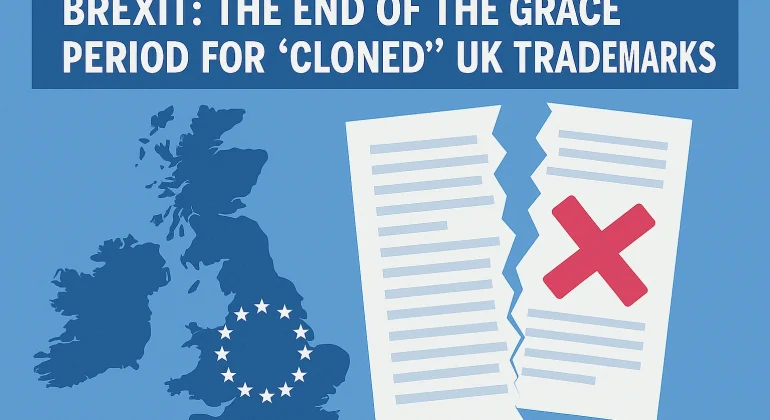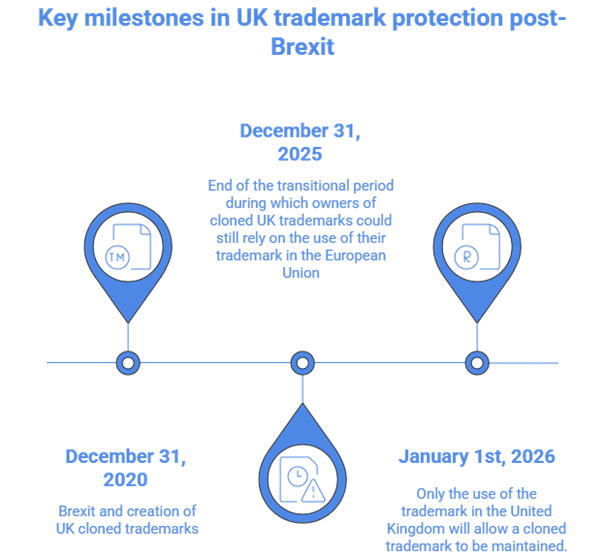Sommaire
Introduction
Genuine use is a fundamental condition for maintaining the validity of a trademark. A trademark may indeed be revoked if it has not been put to genuine use for the goods or services for which it is registered over an uninterrupted period of five years. This requirement prevents the registration of trademarks without real commercial intention and preserves the availability of distinctive signs for other economic operators.
The date of December 31, 2025 stands as a key milestone for EU trademark owners holding a “cloned” UK trademark. As from January 1st, 2026, use of the trademark within the European Union will no longer be accepted to demonstrate genuine use of a cloned UK trademark (often identifiable by a number beginning with 008 or 009). In other words, only actual and effective use of the trademark in the United Kingdom will make it possible to avoid revocation for non-use or to satisfy a proof-of-use request before the UK Intellectual Property Office (UKIPO).
The context of the UK’s withdrawal and the creation of “cloned” UK trademarks
The establishment of “cloned” trademarks in the United Kingdom
When the United Kingdom left the European Union on December 30, 2020, EU trademarks (EUTMs) ceased to automatically cover UK territory. In response, the UKIPO created comparable or “cloned” UK trademarks for every EUTM registered on that date, as well as for international registrations filed through WIPO designating the European Union.
These cloned trademarks retained the filing date, priority and seniority of the original EUTM but became fully independent national UK rights, subject to UK rules on renewal, genuine use, revocation, and invalidity.
The transitional regime for use between the EU and the UK
A transitional mechanism allowed use within the European Union to be taken into account for cloned UK trademarks, provided such use occurred before January 1st, 2021 or if the five-year reference period included use prior to that date.
This transitional bridge remained applicable until the beginning of the new five-year period starting January 1st, 2021. Consequently, from January 1st, 2026, only use in the United Kingdom will be relevant for cloned UK trademarks.
Why is December 31, 2025 a pivotal date for trademark owners?
The end of EU-use recognition for cloned UK trademarks
The turning point is clear: after December 31, 2025, the five-year reference period for assessing genuine use will apply exclusively to use occurring after January 1st, 2021. As a result, use in an EU Member State will no longer be acceptable to justify the use of a cloned UK trademark, only genuine, effective use in the United Kingdom will be considered.
Trademark owners who relied solely on EU-based use must therefore demonstrate real and effective use in the UK. Failing this, their rights will be at risk of revocation for non-use and may no longer serve as a valid basis in opposition or invalidity proceedings.
Consequences for vulnerable trademarks: revocation, loss of enforceability, weakened rights
The consequences are significant:
- A cloned UK trademark that has not been used in the United Kingdom since 2021 will become vulnerable to revocation for non-use as of January 1st, 2026.
- In opposition or invalidation proceedings, proof of use may be required; EU-only use may be deemed insufficient.
- The loss of a cloned trademark may allow a third party to register an identical or similar sign and obtain an earlier right, thereby weakening the former owner’s legal position.
- This calls for heightened vigilance among French and EU trademark owners whose trademarks are active in the EU market but unused in the UK.
What strategies should rights holders adopt as the deadline approaches?
Portfolio audit and proof of use in the United Kingdom
We recommend a multi-step action plan:
- Compile a complete inventory of cloned UK trademarks (prefixes 008 / 009) including specifications of goods and services, filing dates, and renewal deadlines.
- Gather and organise admissible evidence of use: invoices in GBP, delivery notes to UK clients, UK-targeted advertising, “.uk” webpages, listings with UK distributors, etc.
- Assess whether the use qualifies as genuine, meaning real, commercial, and non-symbolic according to UK case law.
- Consider implementing prompt commercial use in the UK before December 31, 2025 if no use exists, while noting that late use may be scrutinised more strictly.
Strategic alternatives: specification limitation, new filing, controlled withdrawal
If genuine use in the UK is not feasible, alternative strategies may be considered:
- Where certain goods or services have never been exploited in the UK, consider limiting the specification or voluntarily surrendering unused parts to reduce exposure to non-use attacks.
- File a new UK trademark application for the same sign with an appropriate specification, restarting the five-year usage period, though with a later filing date and potential opposition risks.
- If the trademark has no commercial relevance in the UK, a strategic non-renewal or controlled withdrawal may be more rational.
For more detailed guidance on defending cloned UK trademarks, we invite you to read our dedicated article.
Conclusion
As December 31, 2025 approaches, concrete steps are required to secure trademark protection in the United Kingdom. Whether through portfolio audits, initiating genuine use in the UK, or implementing alternative filing strategies, time is of the essence.
Dreyfus & Associés assists its clients in managing complex intellectual property cases, offering personalized advice and comprehensive operational support for the complete protection of intellectual property.
Nathalie Dreyfus with the support of the entire Dreyfus team
Q&A
1. What is meant by “genuine use” in the United Kingdom?
It is real and tangible commercial use of the trademark in the UK marketplace, directed to the public and not merely symbolic or preparatory. This may include invoices in GBP, shipments to the UK, targeted advertising, or operation of a “.uk” website.
2. What happens if no action is taken before the deadline?
The cloned UK right will become vulnerable to revocation for non-use (five years of non-use) as of January 1st, 2026, and the owner may lose the ability to enforce the trademark or rely on its earlier filing date.
3. Does this deadline apply to trademarks filed after Brexit?
No. The December 31, 2025 deadline concerns only “cloned” trademarks, meaning those that were automatically created by the UK IPO from EU Trade Trademarks registered no later than 31 December 2020, as well as international registrations designating the EU on that same date. Trademarks filed directly in the United Kingdom after Brexit follow the standard national UK regime, with no connection to former EU rights and no transitional grace period: they are subject to the ordinary UK rules on filing, use, and revocation.
4. What is the territorial scope of cloned trademarks?
Cloned UK trademarks provide protection throughout the entire territory of the United Kingdom, namely England, Scotland, Wales and Northern Ireland.
In certain circumstances, this protection may also extend to Gibraltar, in accordance with applicable UK law.
However, cloned UK trademarks remain entirely distinct from EU Trade Trademarks, which cover only the 27 EU Member States. Since Brexit, no overlap exists between an EU Trade Trademark and a cloned UK trademark: each right must be managed, renewed, and used independently.
5. What if the company has no current market or activity in the UK?
It may be appropriate not to renew the cloned trademark or to limit its specification, so as to avoid unnecessary costs for an unused right. A controlled disengagement strategy may be preferable.


